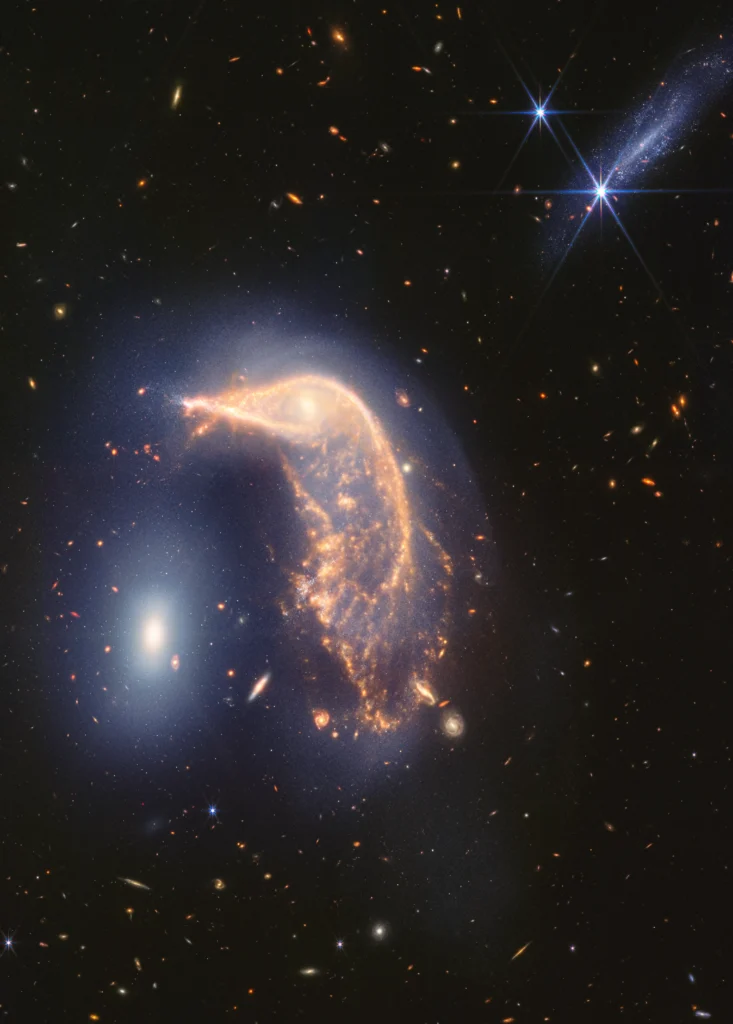Table of Contents
Introduction
James Webb Space Telescope Image of the Penguin and the Egg
On July 12, 2024, NASA revealed a breathtaking image captured by the James Webb Space Telescope (JWST). This image, showcasing the interacting galaxies known as the Penguin and the Egg, stunned the world. This cosmic dance, scientifically named Arp 142, marked a fitting celebration of JWST’s second year of exploration.
Celebrating Two Years of JWST’s Achievements
Two years into its mission, JWST has not only met but exceeded expectations. From its launch in December 2021, the telescope has consistently delivered groundbreaking images and data, deepening our understanding of the universe.

The Galactic Dance of the Penguin and the Egg
The Distorted Spiral: The Penguin
The Penguin, a spiral galaxy, has been dramatically distorted by the gravitational forces of its companion. This distortion creates a mesmerizing swirl of stars and gas, showcasing the raw power of cosmic interactions.
The Compact Elliptical: The Egg
The Egg, a compact elliptical galaxy, is being stretched and elongated in this gravitational embrace. The once smooth shape of the Egg is now irregular, reflecting the intense forces at play.
A 25-75 million Year Cosmic Ballet
This interaction began between 25 and 75 million years ago. The Penguin and the Egg are still in the early stages of their merger, a process that will span hundreds of millions of years before they become one.
Unveiling the Hidden Details
Advanced Instruments: NIRCam and MIRI
JWST’s advanced instruments, including the Near-Infrared Camera (NIRCam) and the Mid-Infrared Instrument (MIRI), played a crucial role in capturing this image. These tools allow astronomers to see through the dust and gas that often obscures such galactic interactions.
Piercing Through Dust and Gas
By combining data from NIRCam and MIRI, astronomers can peer into the heart of these galaxies, revealing details that were previously hidden.
Capturing the Heart of Galactic Interactions
The resulting image is a stunning portrait of two galaxies in the midst of transformation, providing valuable insights into the processes that shape galaxies over time.
The Interplay of Forces
The Penguin’s Distorted Spiral Arms
The gravitational pull of the Egg has dramatically distorted the Penguin’s spiral arms, creating a beautiful and chaotic swirl of stars and gas.
The Egg’s Elongation and Stretch
Simultaneously, the Egg is being stretched and elongated, with its once-smooth elliptical shape becoming increasingly irregular.
A Cosmic Fireworks Display: Star Formation
This interaction triggers bursts of star formation, creating a cosmic fireworks display as new stars ignite throughout the Penguin.
The Vibrant Blue Glow
The Energy Released During Interaction
The intense energy released during the interaction of these galaxies envelops them in a vibrant blue glow. This glow is a testament to the dynamic processes at work.
Star Birth and Death Cycles
As stars are born and die in rapid succession, they shed their outer layers, enriching the surrounding gas with heavy elements.
Stellar Nurseries and New Generations of Stars
This enriched material collapses under gravity, forming new generations of stars and creating a vibrant tapestry of stellar nurseries.
A Living Laboratory for Galaxy Evolution
Insights into Galaxy Mergers
The Penguin and the Egg serve as a living laboratory for astronomers studying galaxy evolution. By observing their interaction, scientists gain valuable insights into the processes that shape galaxies over billions of years.
Impact on Stars and Gas
These observations help answer crucial questions: How do galaxies merge? What happens to the stars and gas during such events?
Influence on Star and Planet Formation
Understanding these interactions provides insight into how they influence the formation of new stars and planets.
The JWST’s Revolutionary Progress
From Launch to Unprecedented Views
When JWST was launched, astronomers were filled with anticipation. The telescope has since provided us with unprecedented views of distant galaxies, exoplanets, and the early universe.
Expanding Frontiers in Astronomy
JWST has opened new frontiers in astronomy and astrophysics, inspiring a new generation of scientists and stargazers alike.
Inspiring Future Generations
The telescope’s discoveries continue to inspire and captivate, fueling curiosity and passion for space exploration.
Looking Ahead: The Next Two Years
Potential Discoveries: Life on Exoplanets
As we look ahead, the potential discoveries are exciting. Could we find evidence of life on a distant exoplanet?
Witnessing Galactic Birth
Will we witness the birth of a new galaxy? JWST’s capabilities make this a real possibility.
Unraveling Dark Matter and Dark Energy Mysteries
The mysteries of dark matter and dark energy are within reach. JWST is poised to help unravel these cosmic enigmas.
Conclusion
The Bright Future of Astronomy
The future of astronomy is bright, and the James Webb Space Telescope is at the forefront, leading the way to new discoveries.
JWST Leading the Way to New Discoveries
With each new image and discovery, we come closer to unlocking the secrets of the universe.
The Anticipation of the Next Cosmic Wonder
As we celebrate JWST’s achievements, we eagerly anticipate the next cosmic wonder that this remarkable telescope will reveal.
Read More Post Like this – NASA : The Mystery of Apollo 13 Mission – Lost in Space
